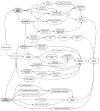Untangling the Impacts of Climate Change on Waterborne Diseases: a Systematic Review of Relationships between Diarrheal Diseases and Temperature, Rainfall, Flooding, and Drought
- PMID: 27058059
- PMCID: PMC5468171
- DOI: 10.1021/acs.est.5b06186
Untangling the Impacts of Climate Change on Waterborne Diseases: a Systematic Review of Relationships between Diarrheal Diseases and Temperature, Rainfall, Flooding, and Drought
Abstract
Global climate change is expected to affect waterborne enteric diseases, yet to date there has been no comprehensive, systematic review of the epidemiological literature examining the relationship between meteorological conditions and diarrheal diseases. We searched PubMed, Embase, Web of Science, and the Cochrane Collection for studies describing the relationship between diarrheal diseases and four meteorological conditions that are expected to increase with climate change: ambient temperature, heavy rainfall, drought, and flooding. We synthesized key areas of agreement and evaluated the biological plausibility of these findings, drawing from a diverse, multidisciplinary evidence base. We identified 141 articles that met our inclusion criteria. Key areas of agreement include a positive association between ambient temperature and diarrheal diseases, with the exception of viral diarrhea and an increase in diarrheal disease following heavy rainfall and flooding events. Insufficient evidence was available to evaluate the effects of drought on diarrhea. There is evidence to support the biological plausibility of these associations, but publication bias is an ongoing concern. Future research evaluating whether interventions, such as improved water and sanitation access, modify risk would further our understanding of the potential impacts of climate change on diarrheal diseases and aid in the prioritization of adaptation measures.
Figures






References
-
- Smith KR, Woodward A, Campbell-Lendrum D, Chadee DD, Honda Y, Liu Q, Olwoch JM, Revich B, Sauerborn R. Human health: impacts, adaptation, and co-benefits. In: Field CB, Barros VR, Dokken DJ, Mach KJ, Mastrandrea MD, Bilir TE, Chatterjee M, Ebi KL, Estrada YO, Genova RC, Girma B, Kissel ES, Levy AN, MacCracken S, Mastrandrea PR, White LL, editors. Climate Change 2014: Impacts, Adaptation, and Vulnerability. Part A: Global and Sectoral Aspects. Contribution of Working Group II to the Fifth Assessment Report of the Intergovernmental Panel on Climate Change. Cambridge University Press; Cambridge and New York: 2014. pp. 709–754.
-
- IPCC. Intergovernmental Panel on Climate Change. Switzerland: 2013. Climate Change 2013. The Physical Science Basis. Working Group I Contribution to the Fifth Assessment Report of the Intergovernmental Panel on Climate Change. Summary for Policymakers.
-
- Luber G, Knowlton K, Balbus J, Frumkin H, Hayden M, Hess J, McGeehin M, Sheats N, Backer L, Beard CB, Ebi KL, Maibach E, Ostfeld RS, Wiedinmyer C, Zielinski-Gutiérrez E, Ziska L. Chapter 9: Human Health. In: Melillo JM, Richmond TC, Yohe GW, editors. Climate Change Impacts in the United States: The Third National Climate Assessment. U.S. Global Change Research Program; Washington, D.C: 2014.
Publication types
MeSH terms
Grants and funding
LinkOut - more resources
Full Text Sources
Other Literature Sources
Medical
Miscellaneous

